CHC50113 Diploma: Assessing Physical and Emotional Wellbeing
VerifiedAdded on 2023/06/07
|64
|13207
|269
Homework Assignment
AI Summary
This assessment workbook for the CHC50113 Diploma of Early Childhood Education and Care focuses on evaluating physical and emotional wellbeing. It includes instructions on competency-based assessment, principles of assessment, dimensions of competency, reasonable adjustments, and avoiding plagiarism. The workbook features a knowledge assessment section with short answer questions and two case studies that require creative and critical thinking. It emphasizes applying knowledge in a practical context relevant to early childhood education settings. The document also covers the rules of evidence (valid, sufficient, authentic, and current) and provides an assessor checklist and feedback section to ensure a comprehensive evaluation process. Desklib provides access to similar past papers and solved assignments for students.
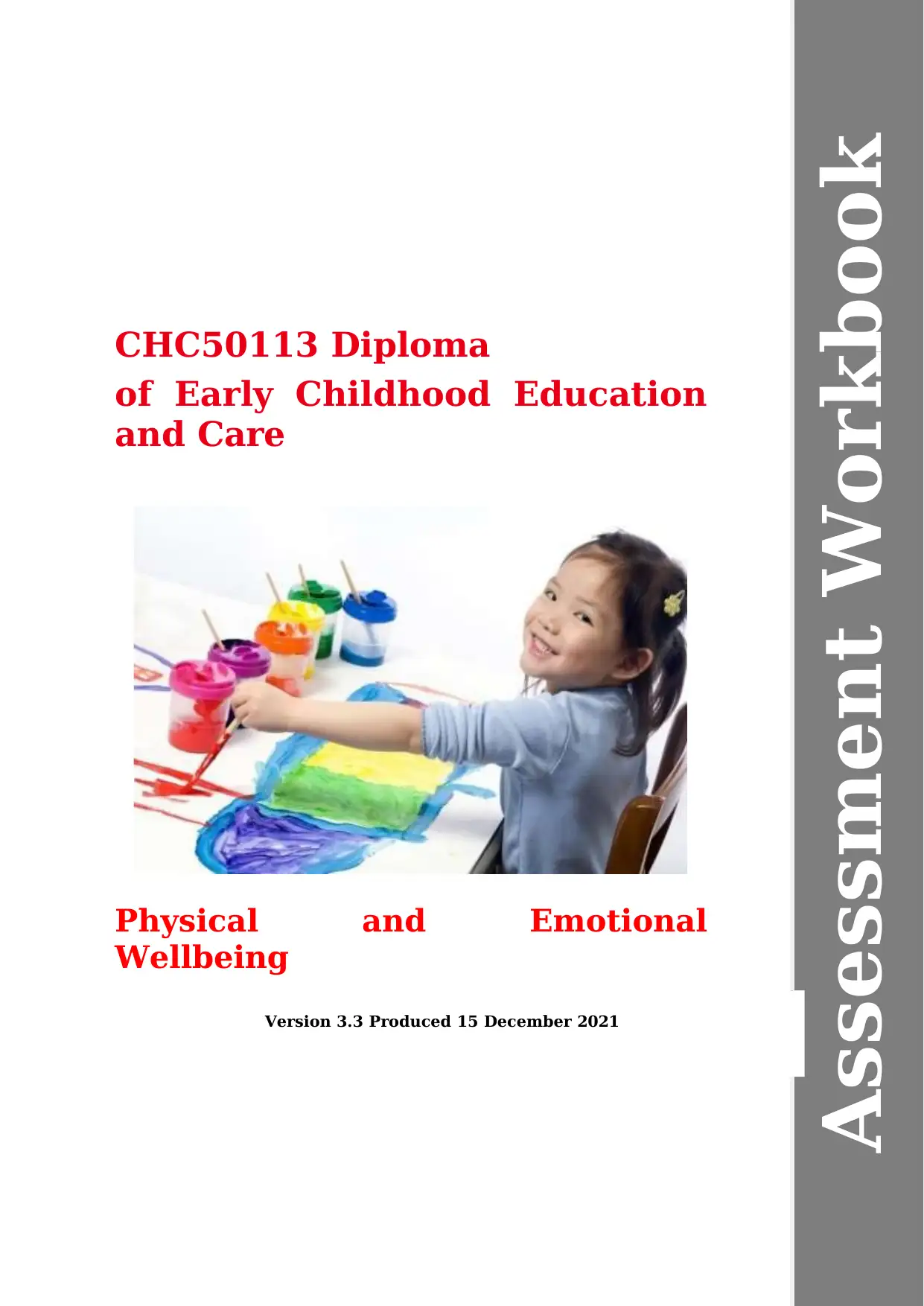
CHC50113 Diploma
of Early Childhood Education
and Care
Physical and Emotional
Wellbeing
Version 3.3 Produced 15 December 2021
Assessment Workbook
of Early Childhood Education
and Care
Physical and Emotional
Wellbeing
Version 3.3 Produced 15 December 2021
Assessment Workbook
Paraphrase This Document
Need a fresh take? Get an instant paraphrase of this document with our AI Paraphraser
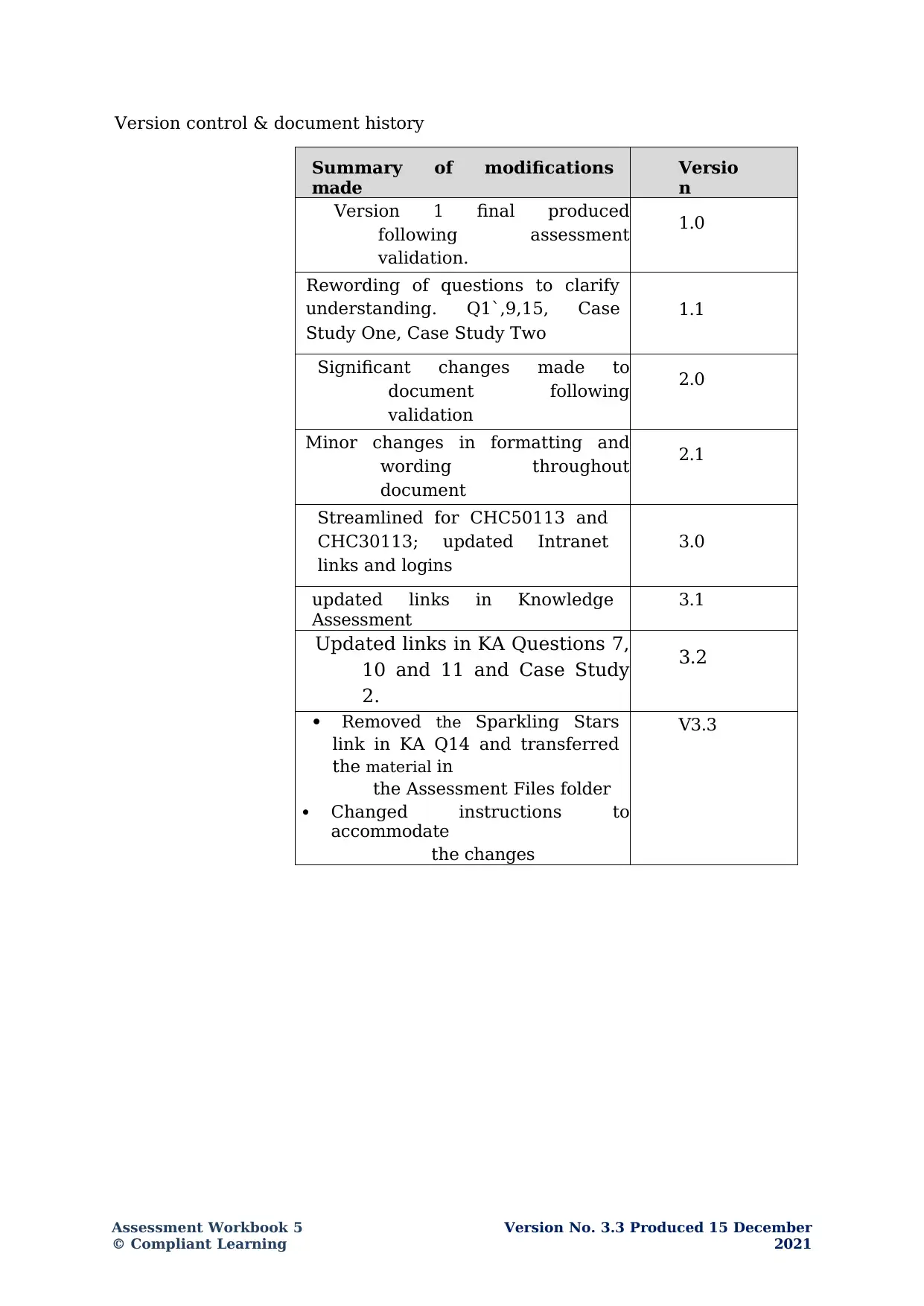
Assessment Workbook 5
© Compliant Learning
Resources
Version No. 3.3 Produced 15 December
2021
Page 2
Version control & document history
Summary of modifications
made
Versio
n
Version 1 final produced
following assessment
validation.
1.0
Rewording of questions to clarify
understanding. Q1`,9,15, Case
Study One, Case Study Two
1.1
Significant changes made to
document following
validation
2.0
Minor changes in formatting and
wording throughout
document
2.1
Streamlined for CHC50113 and
CHC30113; updated Intranet
links and logins
3.0
updated links in Knowledge
Assessment
3.1
Updated links in KA Questions 7,
10 and 11 and Case Study
2.
3.2
Removed the Sparkling Stars
link in KA Q14 and transferred
the material in
the Assessment Files folder
Changed instructions to
accommodate
the changes
V3.3
© Compliant Learning
Resources
Version No. 3.3 Produced 15 December
2021
Page 2
Version control & document history
Summary of modifications
made
Versio
n
Version 1 final produced
following assessment
validation.
1.0
Rewording of questions to clarify
understanding. Q1`,9,15, Case
Study One, Case Study Two
1.1
Significant changes made to
document following
validation
2.0
Minor changes in formatting and
wording throughout
document
2.1
Streamlined for CHC50113 and
CHC30113; updated Intranet
links and logins
3.0
updated links in Knowledge
Assessment
3.1
Updated links in KA Questions 7,
10 and 11 and Case Study
2.
3.2
Removed the Sparkling Stars
link in KA Q14 and transferred
the material in
the Assessment Files folder
Changed instructions to
accommodate
the changes
V3.3
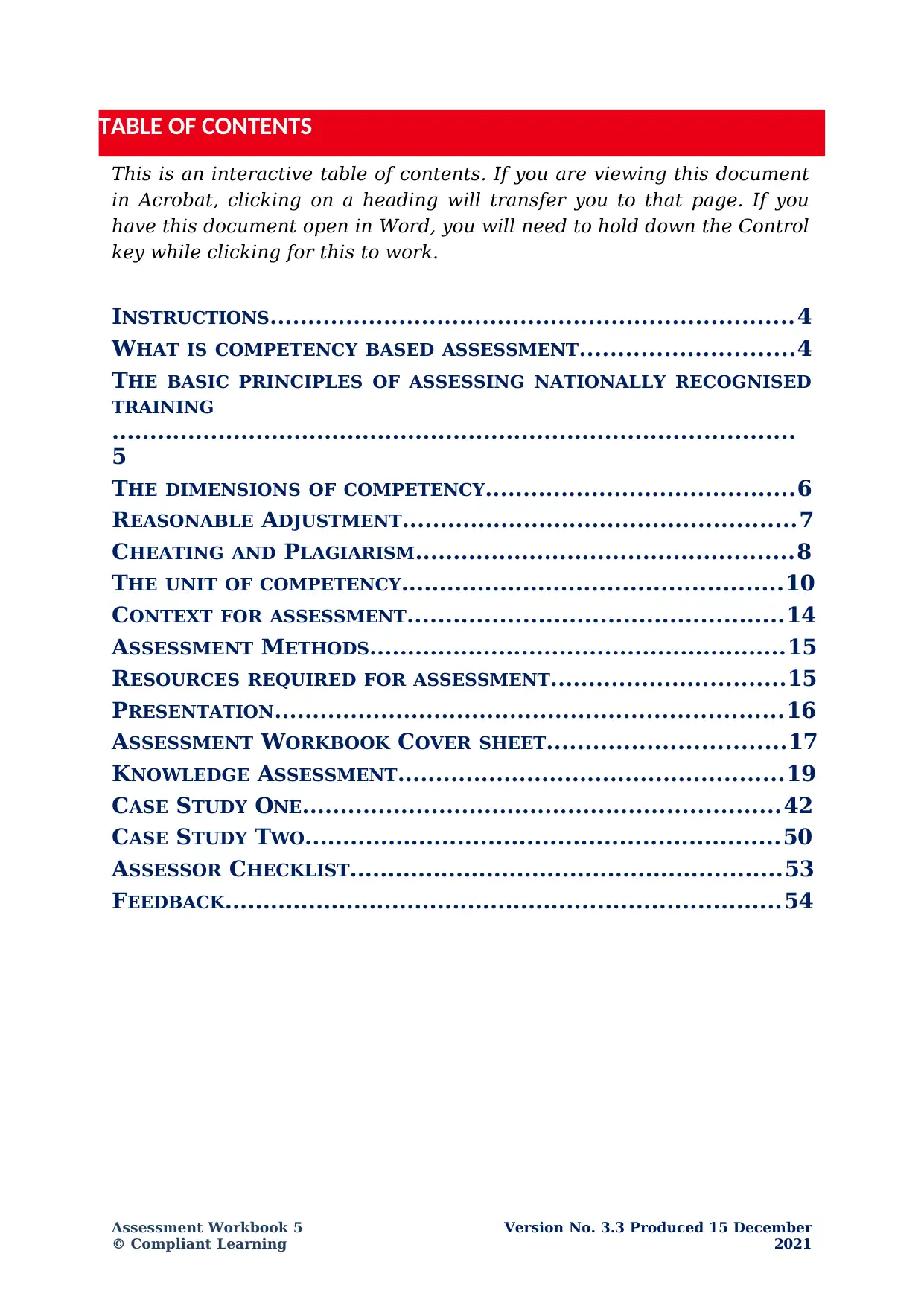
Assessment Workbook 5
© Compliant Learning
Resources
Version No. 3.3 Produced 15 December
2021
Page 3
This is an interactive table of contents. If you are viewing this document
in Acrobat, clicking on a heading will transfer you to that page. If you
have this document open in Word, you will need to hold down the Control
key while clicking for this to work.
INSTRUCTIONS.....................................................................4
WHAT IS COMPETENCY BASED ASSESSMENT............................4
THE BASIC PRINCIPLES OF ASSESSING NATIONALLY RECOGNISED
TRAINING
..........................................................................................
5
THE DIMENSIONS OF COMPETENCY.........................................6
REASONABLE ADJUSTMENT....................................................7
CHEATING AND PLAGIARISM..................................................8
THE UNIT OF COMPETENCY..................................................10
CONTEXT FOR ASSESSMENT.................................................14
ASSESSMENT METHODS.......................................................15
RESOURCES REQUIRED FOR ASSESSMENT...............................15
PRESENTATION...................................................................16
ASSESSMENT WORKBOOK COVER SHEET...............................17
KNOWLEDGE ASSESSMENT...................................................19
CASE STUDY ONE...............................................................42
CASE STUDY TWO..............................................................50
ASSESSOR CHECKLIST.........................................................53
FEEDBACK.........................................................................54
TABLE OF CONTENTS
© Compliant Learning
Resources
Version No. 3.3 Produced 15 December
2021
Page 3
This is an interactive table of contents. If you are viewing this document
in Acrobat, clicking on a heading will transfer you to that page. If you
have this document open in Word, you will need to hold down the Control
key while clicking for this to work.
INSTRUCTIONS.....................................................................4
WHAT IS COMPETENCY BASED ASSESSMENT............................4
THE BASIC PRINCIPLES OF ASSESSING NATIONALLY RECOGNISED
TRAINING
..........................................................................................
5
THE DIMENSIONS OF COMPETENCY.........................................6
REASONABLE ADJUSTMENT....................................................7
CHEATING AND PLAGIARISM..................................................8
THE UNIT OF COMPETENCY..................................................10
CONTEXT FOR ASSESSMENT.................................................14
ASSESSMENT METHODS.......................................................15
RESOURCES REQUIRED FOR ASSESSMENT...............................15
PRESENTATION...................................................................16
ASSESSMENT WORKBOOK COVER SHEET...............................17
KNOWLEDGE ASSESSMENT...................................................19
CASE STUDY ONE...............................................................42
CASE STUDY TWO..............................................................50
ASSESSOR CHECKLIST.........................................................53
FEEDBACK.........................................................................54
TABLE OF CONTENTS
⊘ This is a preview!⊘
Do you want full access?
Subscribe today to unlock all pages.

Trusted by 1+ million students worldwide
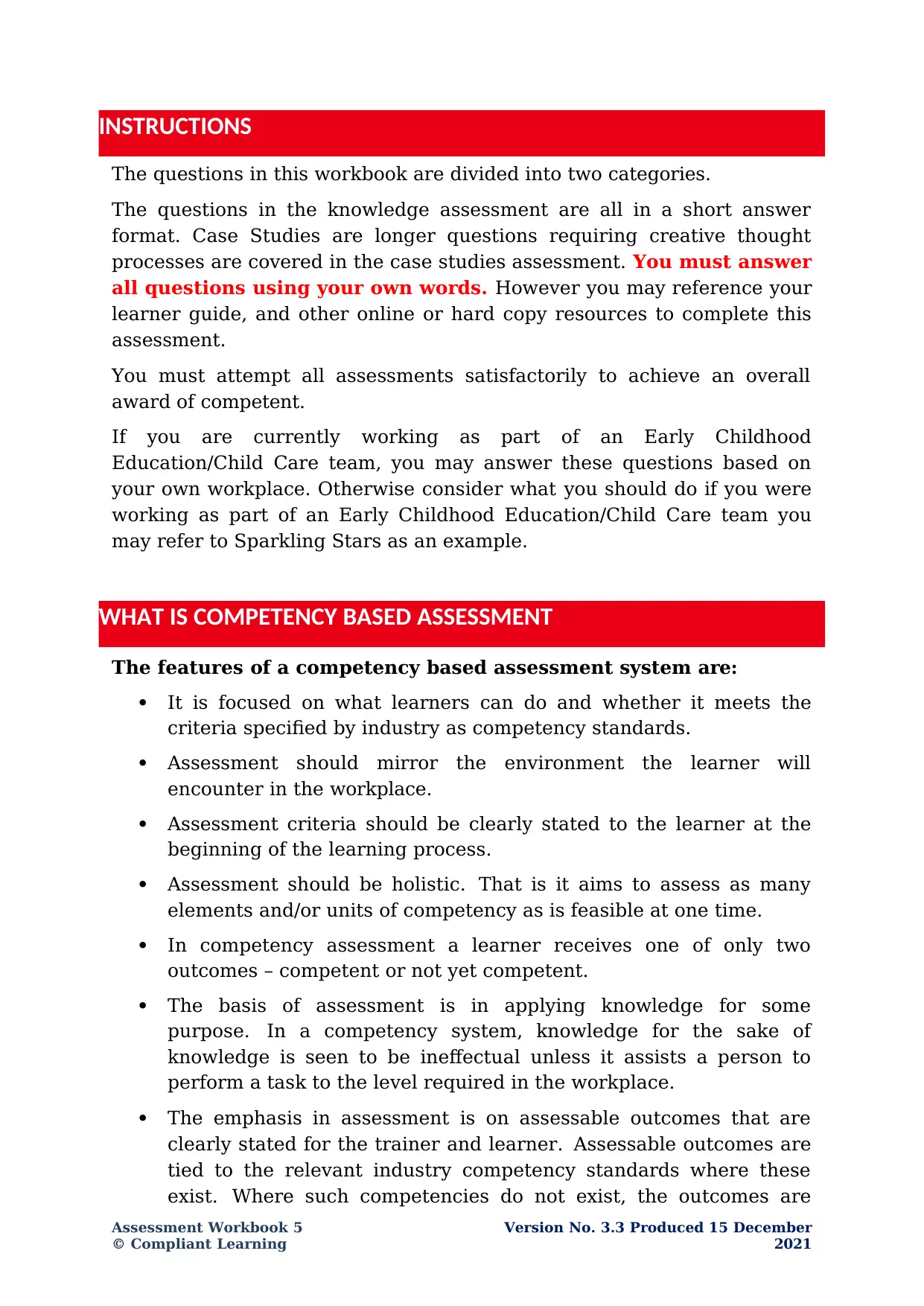
Assessment Workbook 5
© Compliant Learning
Resources
Version No. 3.3 Produced 15 December
2021
Page 4
The questions in this workbook are divided into two categories.
The questions in the knowledge assessment are all in a short answer
format. Case Studies are longer questions requiring creative thought
processes are covered in the case studies assessment. You must answer
all questions using your own words. However you may reference your
learner guide, and other online or hard copy resources to complete this
assessment.
You must attempt all assessments satisfactorily to achieve an overall
award of competent.
If you are currently working as part of an Early Childhood
Education/Child Care team, you may answer these questions based on
your own workplace. Otherwise consider what you should do if you were
working as part of an Early Childhood Education/Child Care team you
may refer to Sparkling Stars as an example.
The features of a competency based assessment system are:
It is focused on what learners can do and whether it meets the
criteria specified by industry as competency standards.
Assessment should mirror the environment the learner will
encounter in the workplace.
Assessment criteria should be clearly stated to the learner at the
beginning of the learning process.
Assessment should be holistic. That is it aims to assess as many
elements and/or units of competency as is feasible at one time.
In competency assessment a learner receives one of only two
outcomes – competent or not yet competent.
The basis of assessment is in applying knowledge for some
purpose. In a competency system, knowledge for the sake of
knowledge is seen to be ineffectual unless it assists a person to
perform a task to the level required in the workplace.
The emphasis in assessment is on assessable outcomes that are
clearly stated for the trainer and learner. Assessable outcomes are
tied to the relevant industry competency standards where these
exist. Where such competencies do not exist, the outcomes are
INSTRUCTIONS
WHAT IS COMPETENCY BASED ASSESSMENT
© Compliant Learning
Resources
Version No. 3.3 Produced 15 December
2021
Page 4
The questions in this workbook are divided into two categories.
The questions in the knowledge assessment are all in a short answer
format. Case Studies are longer questions requiring creative thought
processes are covered in the case studies assessment. You must answer
all questions using your own words. However you may reference your
learner guide, and other online or hard copy resources to complete this
assessment.
You must attempt all assessments satisfactorily to achieve an overall
award of competent.
If you are currently working as part of an Early Childhood
Education/Child Care team, you may answer these questions based on
your own workplace. Otherwise consider what you should do if you were
working as part of an Early Childhood Education/Child Care team you
may refer to Sparkling Stars as an example.
The features of a competency based assessment system are:
It is focused on what learners can do and whether it meets the
criteria specified by industry as competency standards.
Assessment should mirror the environment the learner will
encounter in the workplace.
Assessment criteria should be clearly stated to the learner at the
beginning of the learning process.
Assessment should be holistic. That is it aims to assess as many
elements and/or units of competency as is feasible at one time.
In competency assessment a learner receives one of only two
outcomes – competent or not yet competent.
The basis of assessment is in applying knowledge for some
purpose. In a competency system, knowledge for the sake of
knowledge is seen to be ineffectual unless it assists a person to
perform a task to the level required in the workplace.
The emphasis in assessment is on assessable outcomes that are
clearly stated for the trainer and learner. Assessable outcomes are
tied to the relevant industry competency standards where these
exist. Where such competencies do not exist, the outcomes are
INSTRUCTIONS
WHAT IS COMPETENCY BASED ASSESSMENT
Paraphrase This Document
Need a fresh take? Get an instant paraphrase of this document with our AI Paraphraser
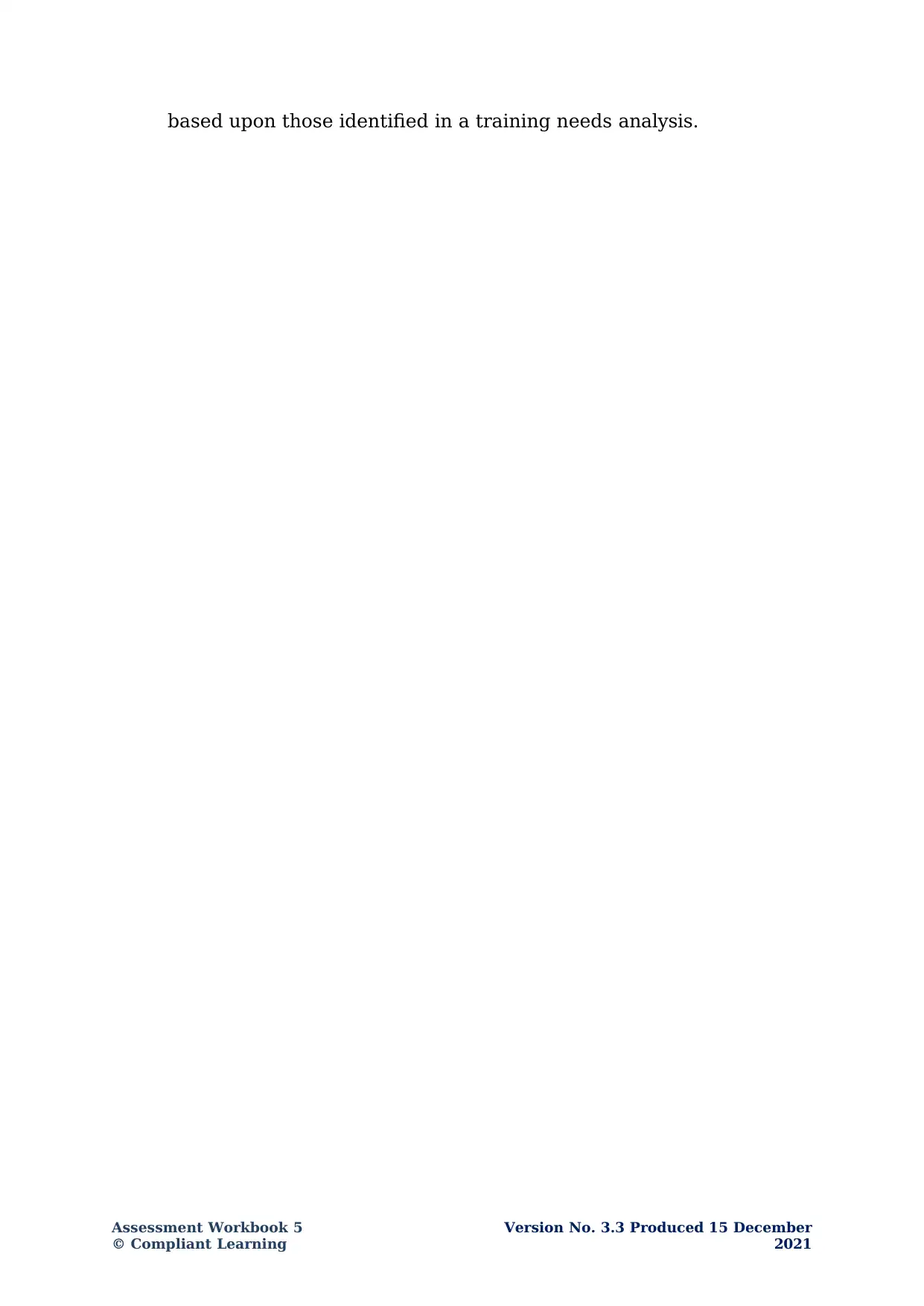
Assessment Workbook 5
© Compliant Learning
Resources
Version No. 3.3 Produced 15 December
2021
Page 5
based upon those identified in a training needs analysis.
© Compliant Learning
Resources
Version No. 3.3 Produced 15 December
2021
Page 5
based upon those identified in a training needs analysis.
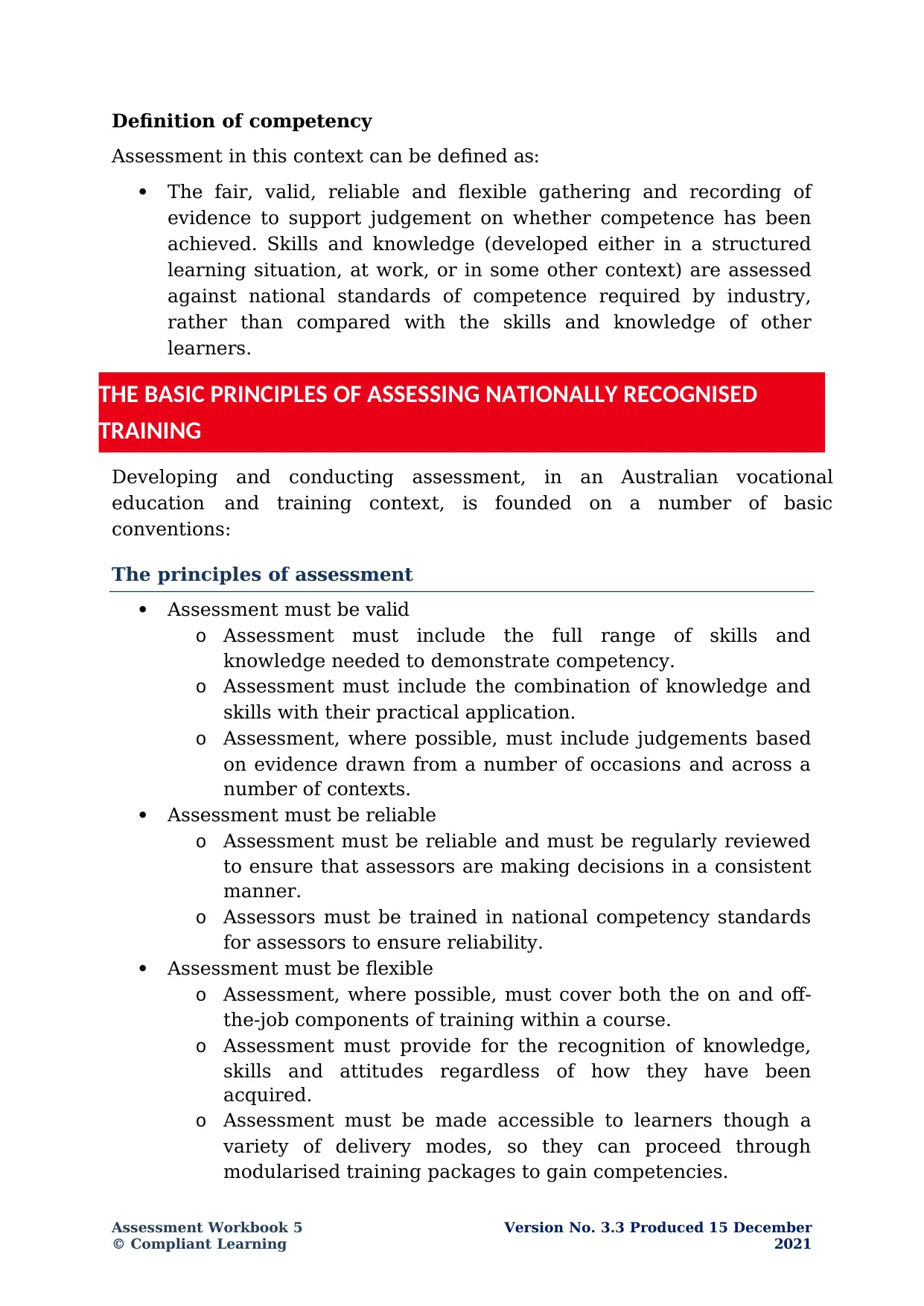
Assessment Workbook 5
© Compliant Learning
Resources
Version No. 3.3 Produced 15 December
2021
Page 6
Definition of competency
Assessment in this context can be defined as:
The fair, valid, reliable and flexible gathering and recording of
evidence to support judgement on whether competence has been
achieved. Skills and knowledge (developed either in a structured
learning situation, at work, or in some other context) are assessed
against national standards of competence required by industry,
rather than compared with the skills and knowledge of other
learners.
Developing and conducting assessment, in an Australian vocational
education and training context, is founded on a number of basic
conventions:
The principles of assessment
Assessment must be valid
o Assessment must include the full range of skills and
knowledge needed to demonstrate competency.
o Assessment must include the combination of knowledge and
skills with their practical application.
o Assessment, where possible, must include judgements based
on evidence drawn from a number of occasions and across a
number of contexts.
Assessment must be reliable
o Assessment must be reliable and must be regularly reviewed
to ensure that assessors are making decisions in a consistent
manner.
o Assessors must be trained in national competency standards
for assessors to ensure reliability.
Assessment must be flexible
o Assessment, where possible, must cover both the on and off-
the-job components of training within a course.
o Assessment must provide for the recognition of knowledge,
skills and attitudes regardless of how they have been
acquired.
o Assessment must be made accessible to learners though a
variety of delivery modes, so they can proceed through
modularised training packages to gain competencies.
THE BASIC PRINCIPLES OF ASSESSING NATIONALLY RECOGNISED
TRAINING
© Compliant Learning
Resources
Version No. 3.3 Produced 15 December
2021
Page 6
Definition of competency
Assessment in this context can be defined as:
The fair, valid, reliable and flexible gathering and recording of
evidence to support judgement on whether competence has been
achieved. Skills and knowledge (developed either in a structured
learning situation, at work, or in some other context) are assessed
against national standards of competence required by industry,
rather than compared with the skills and knowledge of other
learners.
Developing and conducting assessment, in an Australian vocational
education and training context, is founded on a number of basic
conventions:
The principles of assessment
Assessment must be valid
o Assessment must include the full range of skills and
knowledge needed to demonstrate competency.
o Assessment must include the combination of knowledge and
skills with their practical application.
o Assessment, where possible, must include judgements based
on evidence drawn from a number of occasions and across a
number of contexts.
Assessment must be reliable
o Assessment must be reliable and must be regularly reviewed
to ensure that assessors are making decisions in a consistent
manner.
o Assessors must be trained in national competency standards
for assessors to ensure reliability.
Assessment must be flexible
o Assessment, where possible, must cover both the on and off-
the-job components of training within a course.
o Assessment must provide for the recognition of knowledge,
skills and attitudes regardless of how they have been
acquired.
o Assessment must be made accessible to learners though a
variety of delivery modes, so they can proceed through
modularised training packages to gain competencies.
THE BASIC PRINCIPLES OF ASSESSING NATIONALLY RECOGNISED
TRAINING
⊘ This is a preview!⊘
Do you want full access?
Subscribe today to unlock all pages.

Trusted by 1+ million students worldwide
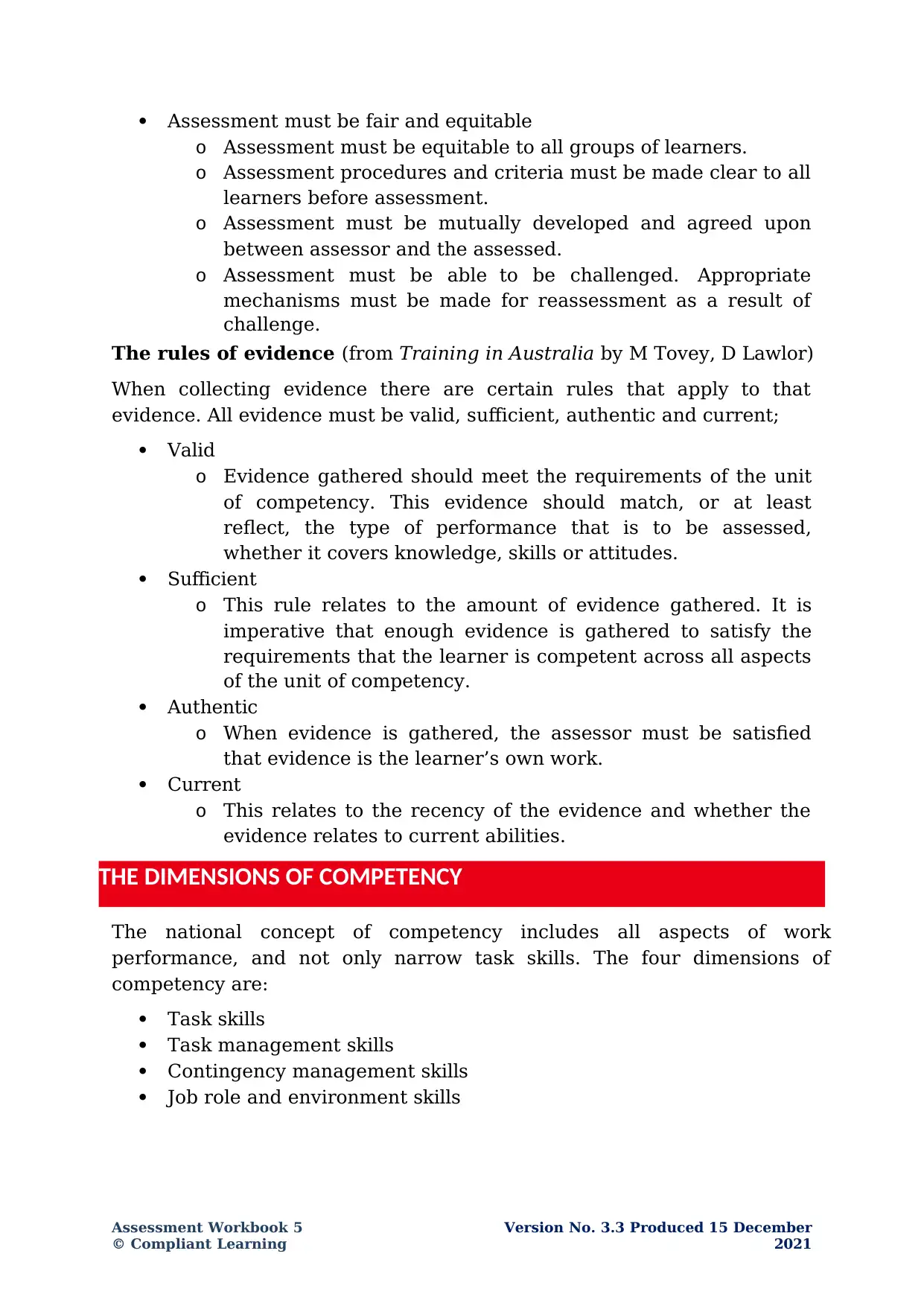
Assessment Workbook 5
© Compliant Learning
Resources
Version No. 3.3 Produced 15 December
2021
Page 7
Assessment must be fair and equitable
o Assessment must be equitable to all groups of learners.
o Assessment procedures and criteria must be made clear to all
learners before assessment.
o Assessment must be mutually developed and agreed upon
between assessor and the assessed.
o Assessment must be able to be challenged. Appropriate
mechanisms must be made for reassessment as a result of
challenge.
The rules of evidence (from Training in Australia by M Tovey, D Lawlor)
When collecting evidence there are certain rules that apply to that
evidence. All evidence must be valid, sufficient, authentic and current;
Valid
o Evidence gathered should meet the requirements of the unit
of competency. This evidence should match, or at least
reflect, the type of performance that is to be assessed,
whether it covers knowledge, skills or attitudes.
Sufficient
o This rule relates to the amount of evidence gathered. It is
imperative that enough evidence is gathered to satisfy the
requirements that the learner is competent across all aspects
of the unit of competency.
Authentic
o When evidence is gathered, the assessor must be satisfied
that evidence is the learner’s own work.
Current
o This relates to the recency of the evidence and whether the
evidence relates to current abilities.
The national concept of competency includes all aspects of work
performance, and not only narrow task skills. The four dimensions of
competency are:
Task skills
Task management skills
Contingency management skills
Job role and environment skills
THE DIMENSIONS OF COMPETENCY
© Compliant Learning
Resources
Version No. 3.3 Produced 15 December
2021
Page 7
Assessment must be fair and equitable
o Assessment must be equitable to all groups of learners.
o Assessment procedures and criteria must be made clear to all
learners before assessment.
o Assessment must be mutually developed and agreed upon
between assessor and the assessed.
o Assessment must be able to be challenged. Appropriate
mechanisms must be made for reassessment as a result of
challenge.
The rules of evidence (from Training in Australia by M Tovey, D Lawlor)
When collecting evidence there are certain rules that apply to that
evidence. All evidence must be valid, sufficient, authentic and current;
Valid
o Evidence gathered should meet the requirements of the unit
of competency. This evidence should match, or at least
reflect, the type of performance that is to be assessed,
whether it covers knowledge, skills or attitudes.
Sufficient
o This rule relates to the amount of evidence gathered. It is
imperative that enough evidence is gathered to satisfy the
requirements that the learner is competent across all aspects
of the unit of competency.
Authentic
o When evidence is gathered, the assessor must be satisfied
that evidence is the learner’s own work.
Current
o This relates to the recency of the evidence and whether the
evidence relates to current abilities.
The national concept of competency includes all aspects of work
performance, and not only narrow task skills. The four dimensions of
competency are:
Task skills
Task management skills
Contingency management skills
Job role and environment skills
THE DIMENSIONS OF COMPETENCY
Paraphrase This Document
Need a fresh take? Get an instant paraphrase of this document with our AI Paraphraser
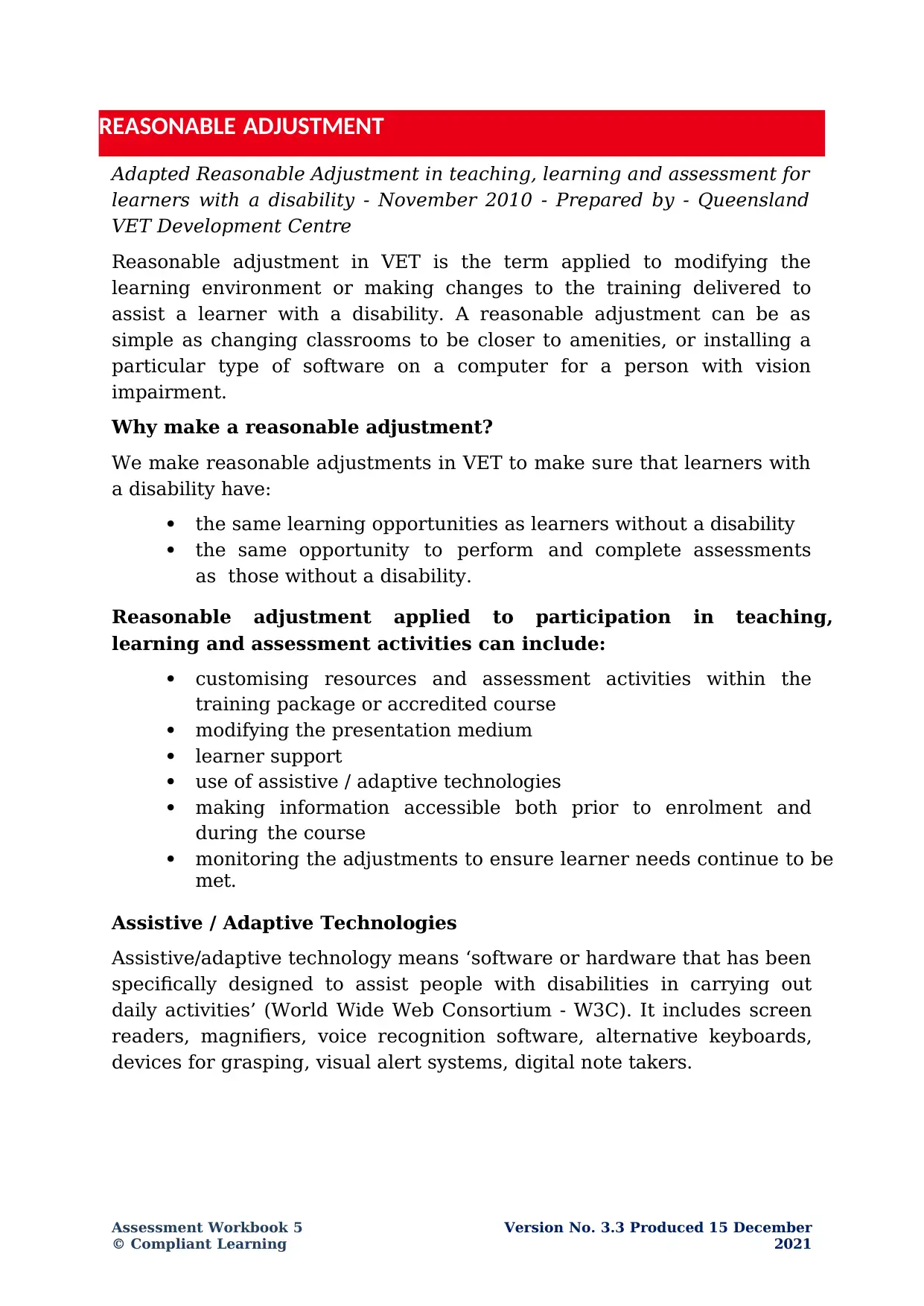
Assessment Workbook 5
© Compliant Learning
Resources
Version No. 3.3 Produced 15 December
2021
Page 8
Adapted Reasonable Adjustment in teaching, learning and assessment for
learners with a disability - November 2010 - Prepared by - Queensland
VET Development Centre
Reasonable adjustment in VET is the term applied to modifying the
learning environment or making changes to the training delivered to
assist a learner with a disability. A reasonable adjustment can be as
simple as changing classrooms to be closer to amenities, or installing a
particular type of software on a computer for a person with vision
impairment.
Why make a reasonable adjustment?
We make reasonable adjustments in VET to make sure that learners with
a disability have:
the same learning opportunities as learners without a disability
the same opportunity to perform and complete assessments
as those without a disability.
Reasonable adjustment applied to participation in teaching,
learning and assessment activities can include:
customising resources and assessment activities within the
training package or accredited course
modifying the presentation medium
learner support
use of assistive / adaptive technologies
making information accessible both prior to enrolment and
during the course
monitoring the adjustments to ensure learner needs continue to be
met.
Assistive / Adaptive Technologies
Assistive/adaptive technology means ‘software or hardware that has been
specifically designed to assist people with disabilities in carrying out
daily activities’ (World Wide Web Consortium - W3C). It includes screen
readers, magnifiers, voice recognition software, alternative keyboards,
devices for grasping, visual alert systems, digital note takers.
REASONABLE ADJUSTMENT
© Compliant Learning
Resources
Version No. 3.3 Produced 15 December
2021
Page 8
Adapted Reasonable Adjustment in teaching, learning and assessment for
learners with a disability - November 2010 - Prepared by - Queensland
VET Development Centre
Reasonable adjustment in VET is the term applied to modifying the
learning environment or making changes to the training delivered to
assist a learner with a disability. A reasonable adjustment can be as
simple as changing classrooms to be closer to amenities, or installing a
particular type of software on a computer for a person with vision
impairment.
Why make a reasonable adjustment?
We make reasonable adjustments in VET to make sure that learners with
a disability have:
the same learning opportunities as learners without a disability
the same opportunity to perform and complete assessments
as those without a disability.
Reasonable adjustment applied to participation in teaching,
learning and assessment activities can include:
customising resources and assessment activities within the
training package or accredited course
modifying the presentation medium
learner support
use of assistive / adaptive technologies
making information accessible both prior to enrolment and
during the course
monitoring the adjustments to ensure learner needs continue to be
met.
Assistive / Adaptive Technologies
Assistive/adaptive technology means ‘software or hardware that has been
specifically designed to assist people with disabilities in carrying out
daily activities’ (World Wide Web Consortium - W3C). It includes screen
readers, magnifiers, voice recognition software, alternative keyboards,
devices for grasping, visual alert systems, digital note takers.
REASONABLE ADJUSTMENT
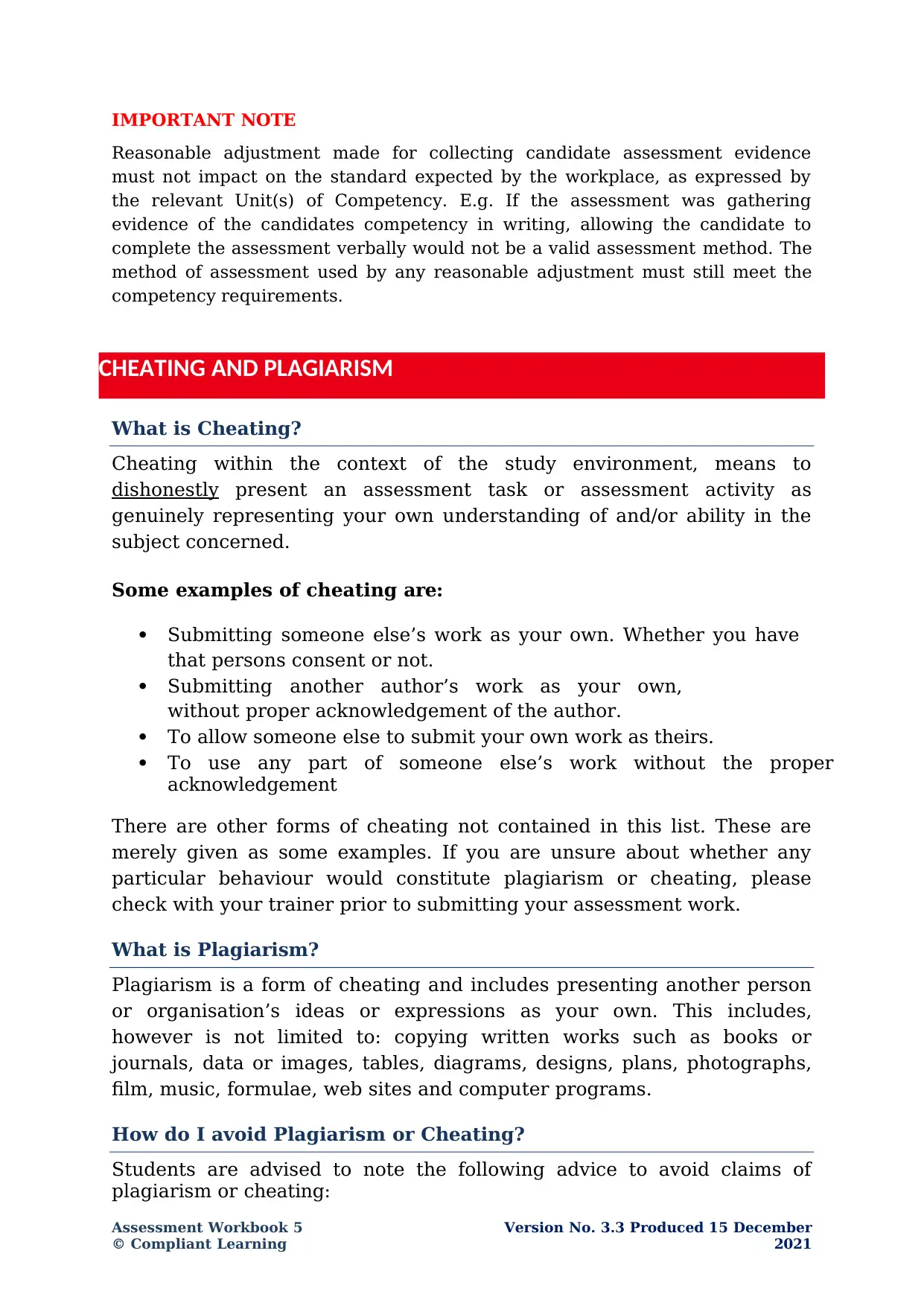
Assessment Workbook 5
© Compliant Learning
Resources
Version No. 3.3 Produced 15 December
2021
Page 9
IMPORTANT NOTE
Reasonable adjustment made for collecting candidate assessment evidence
must not impact on the standard expected by the workplace, as expressed by
the relevant Unit(s) of Competency. E.g. If the assessment was gathering
evidence of the candidates competency in writing, allowing the candidate to
complete the assessment verbally would not be a valid assessment method. The
method of assessment used by any reasonable adjustment must still meet the
competency requirements.
What is Cheating?
Cheating within the context of the study environment, means to
dishonestly present an assessment task or assessment activity as
genuinely representing your own understanding of and/or ability in the
subject concerned.
Some examples of cheating are:
Submitting someone else’s work as your own. Whether you have
that persons consent or not.
Submitting another author’s work as your own,
without proper acknowledgement of the author.
To allow someone else to submit your own work as theirs.
To use any part of someone else’s work without the proper
acknowledgement
There are other forms of cheating not contained in this list. These are
merely given as some examples. If you are unsure about whether any
particular behaviour would constitute plagiarism or cheating, please
check with your trainer prior to submitting your assessment work.
What is Plagiarism?
Plagiarism is a form of cheating and includes presenting another person
or organisation’s ideas or expressions as your own. This includes,
however is not limited to: copying written works such as books or
journals, data or images, tables, diagrams, designs, plans, photographs,
film, music, formulae, web sites and computer programs.
How do I avoid Plagiarism or Cheating?
Students are advised to note the following advice to avoid claims of
plagiarism or cheating:
CHEATING AND PLAGIARISM
© Compliant Learning
Resources
Version No. 3.3 Produced 15 December
2021
Page 9
IMPORTANT NOTE
Reasonable adjustment made for collecting candidate assessment evidence
must not impact on the standard expected by the workplace, as expressed by
the relevant Unit(s) of Competency. E.g. If the assessment was gathering
evidence of the candidates competency in writing, allowing the candidate to
complete the assessment verbally would not be a valid assessment method. The
method of assessment used by any reasonable adjustment must still meet the
competency requirements.
What is Cheating?
Cheating within the context of the study environment, means to
dishonestly present an assessment task or assessment activity as
genuinely representing your own understanding of and/or ability in the
subject concerned.
Some examples of cheating are:
Submitting someone else’s work as your own. Whether you have
that persons consent or not.
Submitting another author’s work as your own,
without proper acknowledgement of the author.
To allow someone else to submit your own work as theirs.
To use any part of someone else’s work without the proper
acknowledgement
There are other forms of cheating not contained in this list. These are
merely given as some examples. If you are unsure about whether any
particular behaviour would constitute plagiarism or cheating, please
check with your trainer prior to submitting your assessment work.
What is Plagiarism?
Plagiarism is a form of cheating and includes presenting another person
or organisation’s ideas or expressions as your own. This includes,
however is not limited to: copying written works such as books or
journals, data or images, tables, diagrams, designs, plans, photographs,
film, music, formulae, web sites and computer programs.
How do I avoid Plagiarism or Cheating?
Students are advised to note the following advice to avoid claims of
plagiarism or cheating:
CHEATING AND PLAGIARISM
⊘ This is a preview!⊘
Do you want full access?
Subscribe today to unlock all pages.

Trusted by 1+ million students worldwide
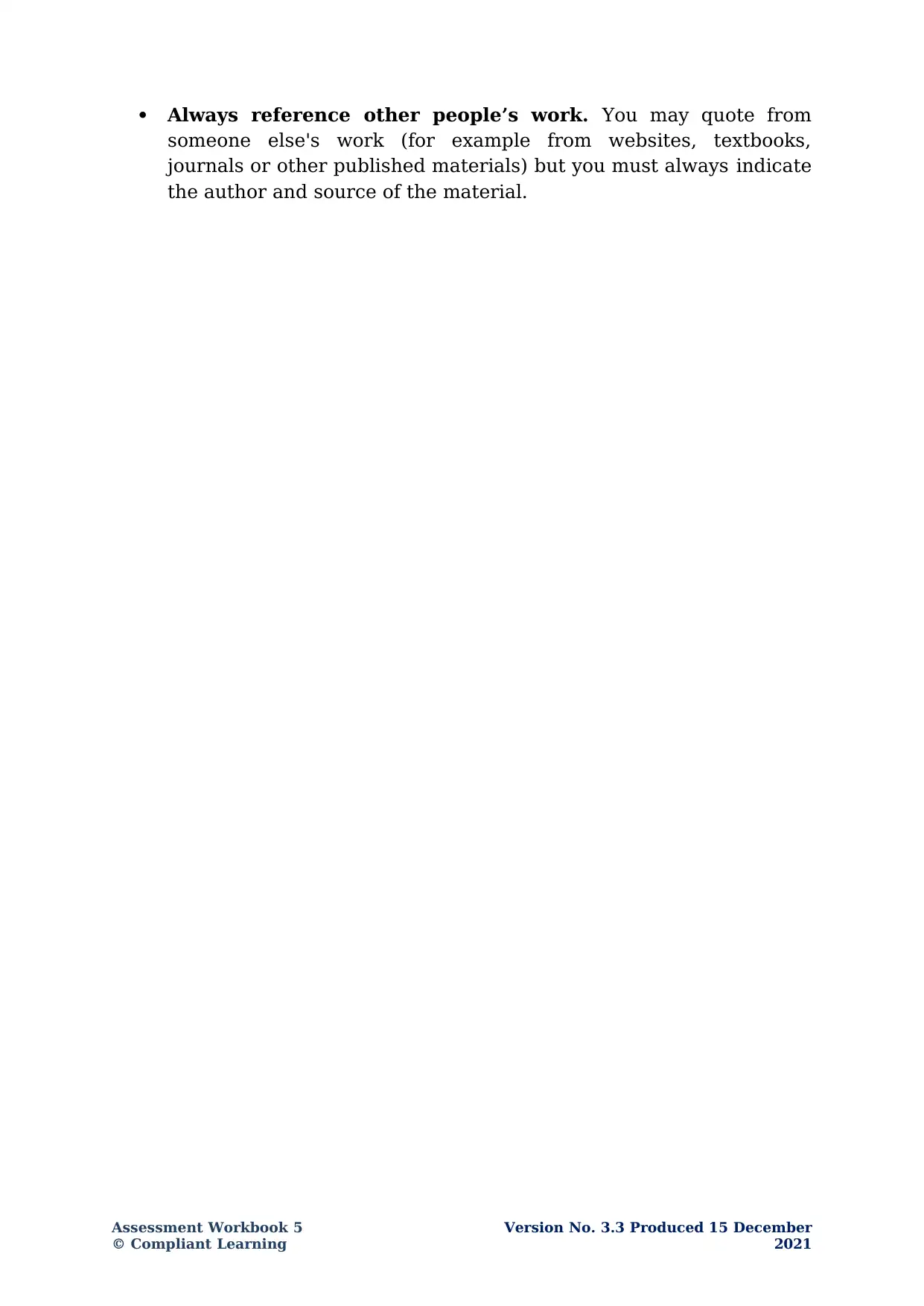
Assessment Workbook 5
© Compliant Learning
Resources
Version No. 3.3 Produced 15 December
2021
Page 10
Always reference other people’s work. You may quote from
someone else's work (for example from websites, textbooks,
journals or other published materials) but you must always indicate
the author and source of the material.
© Compliant Learning
Resources
Version No. 3.3 Produced 15 December
2021
Page 10
Always reference other people’s work. You may quote from
someone else's work (for example from websites, textbooks,
journals or other published materials) but you must always indicate
the author and source of the material.
Paraphrase This Document
Need a fresh take? Get an instant paraphrase of this document with our AI Paraphraser
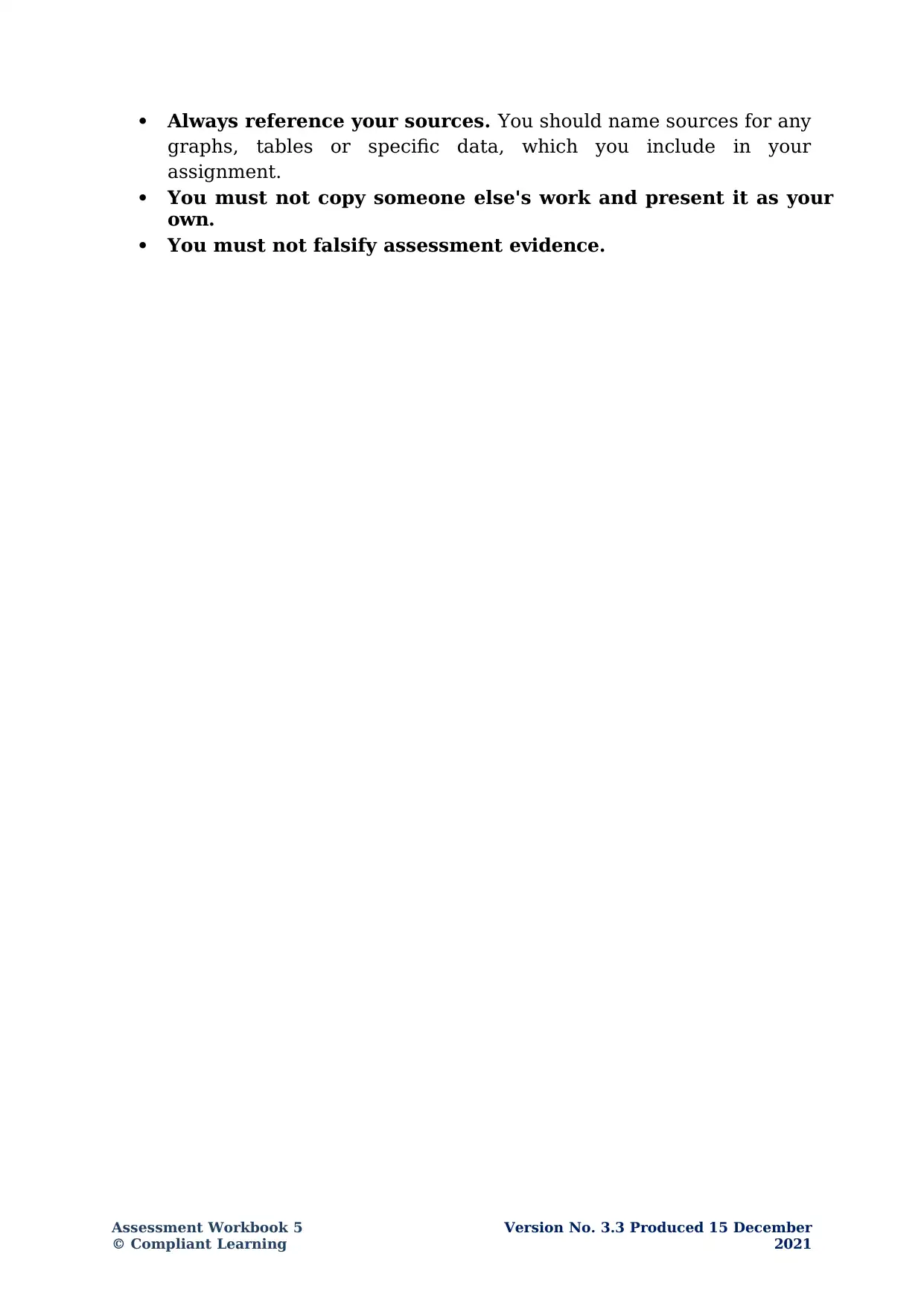
Assessment Workbook 5
© Compliant Learning
Resources
Version No. 3.3 Produced 15 December
2021
Page 11
Always reference your sources. You should name sources for any
graphs, tables or specific data, which you include in your
assignment.
You must not copy someone else's work and present it as your
own.
You must not falsify assessment evidence.
© Compliant Learning
Resources
Version No. 3.3 Produced 15 December
2021
Page 11
Always reference your sources. You should name sources for any
graphs, tables or specific data, which you include in your
assignment.
You must not copy someone else's work and present it as your
own.
You must not falsify assessment evidence.
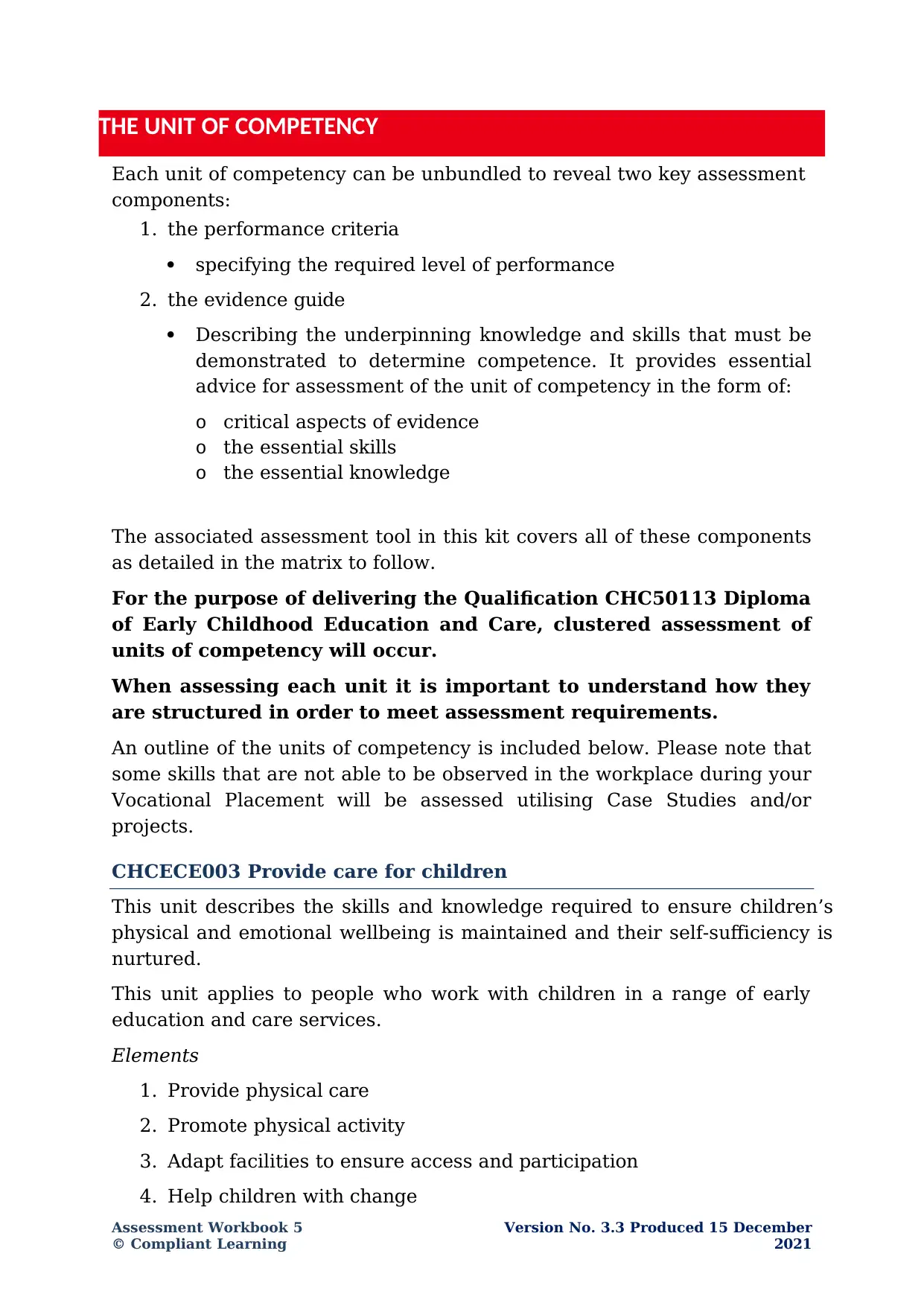
Assessment Workbook 5
© Compliant Learning
Resources
Version No. 3.3 Produced 15 December
2021
Page 12
Each unit of competency can be unbundled to reveal two key assessment
components:
1. the performance criteria
specifying the required level of performance
2. the evidence guide
Describing the underpinning knowledge and skills that must be
demonstrated to determine competence. It provides essential
advice for assessment of the unit of competency in the form of:
o critical aspects of evidence
o the essential skills
o the essential knowledge
The associated assessment tool in this kit covers all of these components
as detailed in the matrix to follow.
For the purpose of delivering the Qualification CHC50113 Diploma
of Early Childhood Education and Care, clustered assessment of
units of competency will occur.
When assessing each unit it is important to understand how they
are structured in order to meet assessment requirements.
An outline of the units of competency is included below. Please note that
some skills that are not able to be observed in the workplace during your
Vocational Placement will be assessed utilising Case Studies and/or
projects.
CHCECE003 Provide care for children
This unit describes the skills and knowledge required to ensure children’s
physical and emotional wellbeing is maintained and their self-sufficiency is
nurtured.
This unit applies to people who work with children in a range of early
education and care services.
Elements
1. Provide physical care
2. Promote physical activity
3. Adapt facilities to ensure access and participation
4. Help children with change
THE UNIT OF COMPETENCY
© Compliant Learning
Resources
Version No. 3.3 Produced 15 December
2021
Page 12
Each unit of competency can be unbundled to reveal two key assessment
components:
1. the performance criteria
specifying the required level of performance
2. the evidence guide
Describing the underpinning knowledge and skills that must be
demonstrated to determine competence. It provides essential
advice for assessment of the unit of competency in the form of:
o critical aspects of evidence
o the essential skills
o the essential knowledge
The associated assessment tool in this kit covers all of these components
as detailed in the matrix to follow.
For the purpose of delivering the Qualification CHC50113 Diploma
of Early Childhood Education and Care, clustered assessment of
units of competency will occur.
When assessing each unit it is important to understand how they
are structured in order to meet assessment requirements.
An outline of the units of competency is included below. Please note that
some skills that are not able to be observed in the workplace during your
Vocational Placement will be assessed utilising Case Studies and/or
projects.
CHCECE003 Provide care for children
This unit describes the skills and knowledge required to ensure children’s
physical and emotional wellbeing is maintained and their self-sufficiency is
nurtured.
This unit applies to people who work with children in a range of early
education and care services.
Elements
1. Provide physical care
2. Promote physical activity
3. Adapt facilities to ensure access and participation
4. Help children with change
THE UNIT OF COMPETENCY
⊘ This is a preview!⊘
Do you want full access?
Subscribe today to unlock all pages.

Trusted by 1+ million students worldwide
1 out of 64
Related Documents
Your All-in-One AI-Powered Toolkit for Academic Success.
+13062052269
info@desklib.com
Available 24*7 on WhatsApp / Email
![[object Object]](/_next/static/media/star-bottom.7253800d.svg)
Unlock your academic potential
Copyright © 2020–2025 A2Z Services. All Rights Reserved. Developed and managed by ZUCOL.





